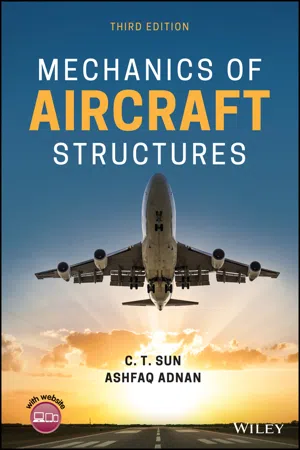
- English
- ePUB (mobile friendly)
- Available on iOS & Android
Mechanics of Aircraft Structures
About this book
Explore the most up-to-date overview of the foundations of aircraft structures combined with a review of new aircraft materials
The newly revised Third Edition of Mechanics of Aircraft Structures delivers a combination of the fundamentals of aircraft structure with an overview of new materials in the industry and a collection of rigorous analysis tools into a single one-stop resource. Perfect for a one-semester introductory course in structural mechanics and aerospace engineering, the distinguished authors have created a textbook that is also ideal for mechanical or aerospace engineers who wish to stay updated on recent advances in the industry.
The new edition contains new problems and worked examples in each chapter and improves student accessibility. A new chapter on aircraft loads and new material on elasticity and structural idealization form part of the expanded content in the book. Readers will also benefit from the inclusion of:
- A thorough introduction to the characteristics of aircraft structures and materials, including the different types of aircraft structures and their basic structural elements
- An exploration of load on aircraft structures, including loads on wing, fuselage, landing gear, and stabilizer structures
- An examination of the concept of elasticity, including the concepts of displacement, strain, and stress, and the equations of equilibrium in a nonuniform stress field
- A treatment of the concept of torsion
Perfect for senior undergraduate and graduate students in aerospace engineering, Mechanics of Aircraft Structures will also earn a place in the libraries of aerospace engineers seeking a one-stop reference to solidify their understanding of the fundamentals of aircraft structures and discover an overview of new materials in the field.
Frequently asked questions
- Essential is ideal for learners and professionals who enjoy exploring a wide range of subjects. Access the Essential Library with 800,000+ trusted titles and best-sellers across business, personal growth, and the humanities. Includes unlimited reading time and Standard Read Aloud voice.
- Complete: Perfect for advanced learners and researchers needing full, unrestricted access. Unlock 1.4M+ books across hundreds of subjects, including academic and specialized titles. The Complete Plan also includes advanced features like Premium Read Aloud and Research Assistant.
Please note we cannot support devices running on iOS 13 and Android 7 or earlier. Learn more about using the app.
Information
1
Characteristics of Aircraft Structures and Materials
1.1 INTRODUCTION
1.2 TYPES OF AIRCRAFT STRUCTURES
1.2.1 Fixed‐Wing Aircraft
Table of contents
- Cover
- Table of Contents
- Title Page
- Copyright Page
- Dedication Page
- Preface to the Third Edition
- Preface to the Second Edition
- Preface to the First Edition
- About the Companion Website
- 1 Characteristics of Aircraft Structures and Materials
- 2 Loads on Aircraft Structures
- 3 Introduction to Elasticity
- 4 Torsion
- 5 Bending and Flexural Shear
- 6 Flexural Shear Flow in Thin‐Walled Sections
- 7 Failure Criteria for Isotropic Materials
- 8 Elastic Buckling
- 9 Analysis of Composite Laminates
- Index
- End User License Agreement